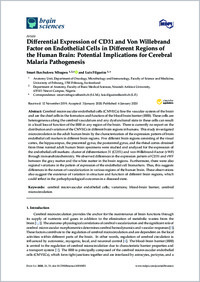Differential expression of CD31 and von Willebrand factor on endothelial cells in different regions of the human brain: potential implications for cerebral malaria pathogenesis
- Mbagwu, Smart Ikechukwu Anatomy Unit, Department of Oncology, Microbiology and Immunology, Faculty of Science and Medicine, University of Fribourg, Switzerland - Department of Anatomy, Faculty of Basic Medical Sciences, Nnamdi Azikiwe University, Nigeria
- Filgueira, Luis Anatomy Unit, Department of Oncology, Microbiology and Immunology, Faculty of Science and Medicine, University of Fribourg, Switzerland
-
06.01.2020
Published in:
- Brain Sciences. - 2020, vol. 10, no. 1, p. 31
English
Cerebral microvascular endothelial cells (CMVECs) line the vascular system of the brain and are the chief cells in the formation and function of the blood brain barrier (BBB). These cells are heterogeneous along the cerebral vasculature and any dysfunctional state in these cells can result in a local loss of function of the BBB in any region of the brain. There is currently no report on the distribution and variation of the CMVECs in different brain regions in humans. This study investigated microcirculation in the adult human brain by the characterization of the expression pattern of brain endothelial cell markers in different brain regions. Five different brain regions consisting of the visual cortex, the hippocampus, the precentral gyrus, the postcentral gyrus, and the rhinal cortex obtained from three normal adult human brain specimens were studied and analyzed for the expression of the endothelial cell markers: cluster of differentiation 31 (CD31) and von-Willebrand-Factor (vWF) through immunohistochemistry. We observed differences in the expression pattern of CD31 and vWF between the gray matter and the white matter in the brain regions. Furthermore, there were also regional variations in the pattern of expression of the endothelial cell biomarkers. Thus, this suggests differences in the nature of vascularization in various regions of the human brain. These observations also suggest the existence of variation in structure and function of different brain regions, which could reflect in the pathophysiological outcomes in a diseased state.
- Faculty
- Faculté des sciences et de médecine
- Department
- Département de Médecine
- Language
-
- English
- Classification
- Biological sciences
- License
-
License undefined
- Identifiers
-
- RERO DOC 328215
- DOI 10.3390/brainsci10010031
- Persistent URL
- https://folia.unifr.ch/unifr/documents/308549
Statistics
Document views: 127
File downloads:
- pdf: 214
